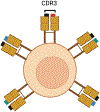The quantum model of T-cell activation: Revisiting immune response theories
- PMID: 38750629
- PMCID: PMC11250909
- DOI: 10.1111/sji.13375
The quantum model of T-cell activation: Revisiting immune response theories
Abstract
Our understanding of the immune response is far from complete, missing out on more detailed explanations that could be provided by molecular insights. To bridge this gap, we introduce the quantum model of T-cell activation. This model suggests that the transfer of energy during protein phosphorylation within T cells is not a continuous flow but occurs in discrete bursts, or 'quanta', of phosphates. This quantized energy transfer is mediated by oscillating cycles of receptor phosphorylation and dephosphorylation, initiated by dynamic 'catch-slip' pulses in the peptide-major histocompatibility complex-T-cell receptor (pMHC-TcR) interactions. T-cell activation is predicated upon achieving a critical threshold of catch-slip pulses at the pMHC-TcR interface. Costimulation is relegated to a secondary role, becoming crucial only when the frequency of pMHC-TcR catch-slip pulses does not meet the necessary threshold for this quanta-based energy transfer. Therefore, our model posits that it is the quantum nature of energy transfer-not the traditional signal I or signal II-that plays the decisive role in T-cell activation. This paradigm shift highlights the importance of understanding T-cell activation through a quantum lens, offering a potentially transformative perspective on immune response regulation.
Keywords: cells; T cells; molecules; MHC; molecules; T cell receptors.
© 2024 The Authors. Scandinavian Journal of Immunology published by John Wiley & Sons Ltd on behalf of The Scandinavian Foundation for Immunology.
Figures


Similar articles
-
Antiemetics for adults for prevention of nausea and vomiting caused by moderately or highly emetogenic chemotherapy: a network meta-analysis.Cochrane Database Syst Rev. 2021 Nov 16;11(11):CD012775. doi: 10.1002/14651858.CD012775.pub2. Cochrane Database Syst Rev. 2021. PMID: 34784425 Free PMC article.
-
The role of peptide conformation presented by MHC in the induction of TCR triggering.Biophys J. 2025 Apr 1;124(7):1073-1084. doi: 10.1016/j.bpj.2025.02.001. Epub 2025 Feb 7. Biophys J. 2025. PMID: 39921257
-
Short-Term Memory Impairment.2024 Jun 8. In: StatPearls [Internet]. Treasure Island (FL): StatPearls Publishing; 2025 Jan–. 2024 Jun 8. In: StatPearls [Internet]. Treasure Island (FL): StatPearls Publishing; 2025 Jan–. PMID: 31424720 Free Books & Documents.
-
123I-MIBG scintigraphy and 18F-FDG-PET imaging for diagnosing neuroblastoma.Cochrane Database Syst Rev. 2015 Sep 29;2015(9):CD009263. doi: 10.1002/14651858.CD009263.pub2. Cochrane Database Syst Rev. 2015. PMID: 26417712 Free PMC article.
-
Sexual Harassment and Prevention Training.2024 Mar 29. In: StatPearls [Internet]. Treasure Island (FL): StatPearls Publishing; 2025 Jan–. 2024 Mar 29. In: StatPearls [Internet]. Treasure Island (FL): StatPearls Publishing; 2025 Jan–. PMID: 36508513 Free Books & Documents.
Cited by
-
On the nature of signal 1 delivered to lymphocytes: A critical response to some considerations put forward in support of the quantum model of T cell activation.Scand J Immunol. 2025 Feb;101(2):e70002. doi: 10.1111/sji.70002. Scand J Immunol. 2025. PMID: 39957340 Free PMC article. Review.
-
Redefining the Immunobiology of Organ Transplantation for New Clinical Horizons.Scand J Immunol. 2025 Aug;102(2):e70045. doi: 10.1111/sji.70045. Scand J Immunol. 2025. PMID: 40717391 Free PMC article. Review.
References
-
- BURNET FM, Fenner F. The production of antibodies. 2nd. Melbourne/London: Macmillan; 1949.
-
- Matzinger P. Tolerance, danger, and the extended family. Annu. Rev. Immunol 1994;12:991–1045. - PubMed
-
- Lafferty KJ, Warren HS, Woolnough JA, Talmage DW. Immunological induction of T lymphocytes: role of antigen and the lymphocyte costimulator. Blood Cells 1978;4:395–406. - PubMed
-
- Janeway CA Jr. The immune system evolved to discriminate infectious nonself from noninfectious self. Immunol. Today 1992;13:11–6. - PubMed
MeSH terms
Substances
Grants and funding
LinkOut - more resources
Full Text Sources
Research Materials
Miscellaneous

